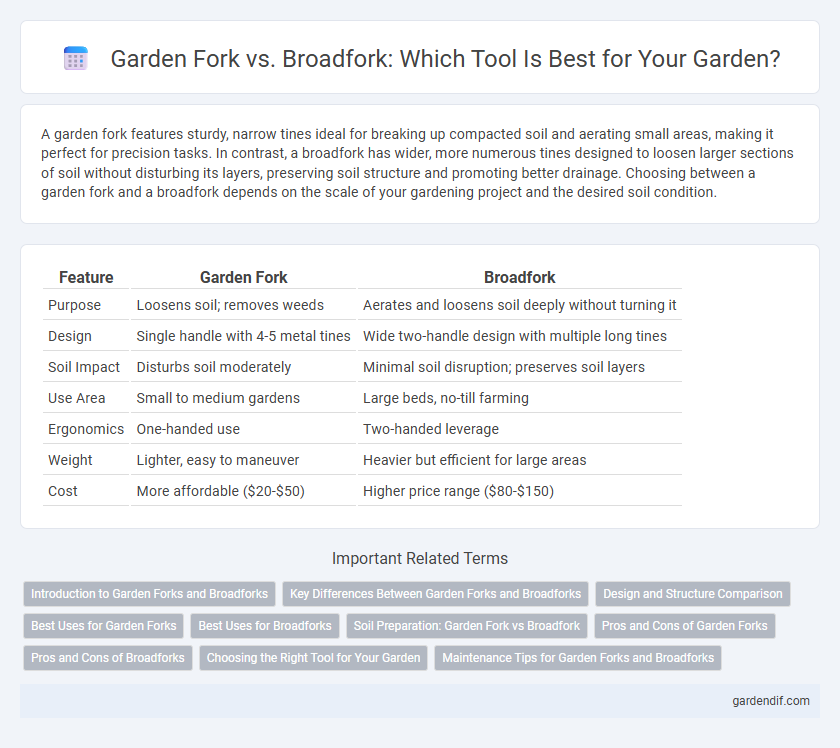
Garden Fork vs Broadfork Illustration
A garden fork features sturdy, narrow tines ideal for breaking up compacted soil and aerating small areas, making it perfect for precision tasks. In contrast, a broadfork has wider, more numerous tines designed to loosen larger sections of soil without disturbing its layers, preserving soil structure and promoting better drainage. Choosing between a garden fork and a broadfork depends on the scale of your gardening project and the desired soil condition.
Table of Comparison
| Feature | Garden Fork | Broadfork |
|---|---|---|
| Purpose | Loosens soil; removes weeds | Aerates and loosens soil deeply without turning it |
| Design | Single handle with 4-5 metal tines | Wide two-handle design with multiple long tines |
| Soil Impact | Disturbs soil moderately | Minimal soil disruption; preserves soil layers |
| Use Area | Small to medium gardens | Large beds, no-till farming |
| Ergonomics | One-handed use | Two-handed leverage |
| Weight | Lighter, easy to maneuver | Heavier but efficient for large areas |
| Cost | More affordable ($20-$50) | Higher price range ($80-$150) |
Introduction to Garden Forks and Broadforks
Garden forks feature sturdy, pointed tines designed for digging, turning, and aerating soil in confined spaces, making them ideal for smaller garden beds and precise tasks. Broadforks, equipped with wider, longer tines and a horizontal handle, excel at loosening larger areas of compacted soil without disturbing soil layers or structure. Each tool optimizes soil preparation by targeting specific gardening needs: the garden fork for detailed soil manipulation and the broadfork for extensive soil aeration and loosening.
Key Differences Between Garden Forks and Broadforks
Garden forks feature straight, sturdy tines ideal for digging and breaking up soil in smaller garden beds, while broadforks have longer, curved tines designed to aerate and loosen larger soil areas without disturbing the soil layers. The garden fork's compact design allows for precise digging and turning compost, whereas the broadfork uses leverage to minimize soil compaction and maintain soil structure. Garden forks are typically made of heavy-duty steel with four or more tines, whereas broadforks have two handles and a wider tine spacing to cover more ground efficiently.
Design and Structure Comparison
A garden fork features a single handle with sturdy, closely spaced tines designed for turning soil and breaking up compacted ground. In contrast, a broadfork consists of a wider frame with two handles and longer, widely spaced tines that allow for aerating and loosening soil without disturbing its layers. The structural difference allows the broadfork to cover larger areas efficiently, making it ideal for deep soil cultivation in raised beds and large gardens.
Best Uses for Garden Forks
Garden forks excel in breaking up compacted soil and turning compost, making them ideal for smaller garden beds and raised planters. Their sturdy, closely spaced tines penetrate hard ground effectively, aiding in aeration and weed removal without disturbing nearby plants. Garden forks are best used for soil cultivation in tighter spaces where precision and control are essential.
Best Uses for Broadforks
Broadforks are ideal for deep aeration and loosening compacted soil without disrupting soil structure, making them perfect for preparing garden beds and promoting healthy root growth. Their wide, ergonomic tines allow for efficient turning of larger soil areas, which is beneficial in larger vegetable gardens or landscaping projects. Unlike garden forks, broadforks maintain soil layers intact, preserving beneficial microbial habitats essential for sustainable gardening.
Soil Preparation: Garden Fork vs Broadfork
A garden fork features sturdy, closely spaced tines ideal for breaking up compacted soil and aerating garden beds, making it effective for smaller plots and precision work. Broadforks, with wider-spaced tines and a lever-like handle, are designed for loosening larger soil areas without turning or disturbing soil layers, preserving soil structure and microbial activity. For efficient soil preparation in raised beds or extensive garden plots, broadforks reduce strain and maintain soil health, whereas garden forks excel in targeted soil penetration and compost mixing.
Pros and Cons of Garden Forks
Garden forks offer excellent versatility for aerating compacted soil and breaking up clumps, making them ideal for smaller garden beds and precise cultivation. Their sturdy tines can easily penetrate tough soil but may struggle with larger, rockier areas where broader tools like broadforks excel. While garden forks are generally lighter and easier to maneuver, they require more effort for wide coverage, limiting efficiency in large-scale soil loosening tasks.
Pros and Cons of Broadforks
Broadforks provide excellent soil aeration and preservation of soil structure by loosening soil without turning it, which helps maintain beneficial microorganisms and reduces compaction. They require significant physical effort compared to garden forks, making them less suitable for smaller or harder soils but ideal for preparing larger beds efficiently. Their wide tines cover more ground per stroke, increasing productivity during deep cultivation and improving root growth and drainage.
Choosing the Right Tool for Your Garden
Garden forks offer robust, narrow tines ideal for breaking compacted soil in smaller garden beds, while broadforks feature wider spacing and longer handles, making them perfect for aerating larger areas without disturbing soil layers. Selecting the right tool depends on garden size and soil condition; garden forks excel in tight spaces and heavy soil, whereas broadforks reduce physical strain and preserve soil structure over expansive plots. Consider soil type, garden dimensions, and ergonomic needs to optimize soil health and ease of use.
Maintenance Tips for Garden Forks and Broadforks
Regularly cleaning garden forks and broadforks after use prevents rust and soil buildup, extending tool lifespan. Sharpening tines with a file ensures efficient soil penetration, while storing tools in dry, sheltered areas minimizes corrosion. Periodic inspection for bent or damaged tines allows timely repairs, maintaining optimal performance in soil cultivation.
Garden Fork vs Broadfork Infographic

 gardendif.com
gardendif.com